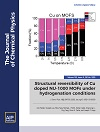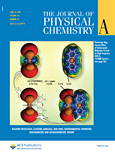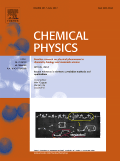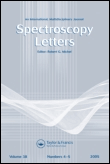
JOURNAL OF CHEMICAL PHYSICS
Scope & Guideline
Advancing the Frontiers of Chemical Physics
Introduction
Aims and Scopes
- Spectroscopy Techniques:
The journal features extensive research on various spectroscopic techniques, including vibrational spectroscopy, ultrafast spectroscopy, and photoelectron spectroscopy, focusing on their application to understand molecular interactions and dynamics. - Molecular Dynamics and Simulations:
A core area of research involves the use of molecular dynamics simulations and quantum mechanical calculations to investigate chemical reactions, adsorption processes, and structural properties of various materials. - Nanomaterials and Catalysis:
Research on nanostructured materials and their catalytic properties is prominent, exploring their applications in areas such as photocatalysis and electrocatalysis. - Theoretical Chemistry:
Theoretical studies that provide insights into reaction mechanisms, potential energy surfaces, and the electronic structure of molecules are a significant focus, contributing to the understanding of complex chemical systems. - Machine Learning in Chemistry:
An emerging theme includes the application of machine learning techniques to accelerate materials discovery, molecular property prediction, and the optimization of chemical processes.
Trending and Emerging
- Ultrafast Dynamics:
Research on ultrafast dynamics, including time-resolved spectroscopy and electron dynamics, is gaining momentum, driven by the need to understand rapid chemical processes and molecular interactions on extremely short timescales. - Machine Learning and AI Applications:
The integration of machine learning and artificial intelligence in chemical research is rapidly expanding, with studies focusing on predicting molecular properties, optimizing reaction conditions, and accelerating the discovery of new materials. - Nanostructured Materials and Applications:
There is an increasing focus on nanomaterials, particularly in the context of their catalytic properties and applications in energy conversion and storage, reflecting the growing interest in sustainable technologies. - Interfacial Phenomena:
Research exploring interfacial phenomena, particularly in the context of catalysis and material interfaces, is on the rise, highlighting the importance of surfaces and interfaces in chemical reactions. - Quantum Chemistry and Non-adiabatic Dynamics:
The application of quantum chemistry methods to study non-adiabatic processes and complex reaction dynamics is trending, emphasizing the need for advanced theoretical frameworks to describe intricate molecular interactions.
Declining or Waning
- Traditional Organic Chemistry:
Research focused on classical organic chemistry methods and reactions has decreased, as the journal shifts towards more interdisciplinary approaches that combine chemistry with physics and materials science. - Static Theoretical Models:
There has been a waning interest in static theoretical models that do not incorporate dynamic effects, as researchers increasingly favor approaches that consider time-dependent phenomena and non-adiabatic processes. - Inorganic Chemistry Studies:
The number of publications centered solely on traditional inorganic chemistry appears to be declining, potentially due to a broader focus on applications in catalysis and materials science. - Spectroscopic Methods with Limited Scope:
Some traditional spectroscopic methods that do not integrate advanced techniques or interdisciplinary approaches are becoming less common, as more innovative and multi-faceted techniques gain traction.
Similar Journals

JOURNAL OF PHYSICAL CHEMISTRY A
Elevating knowledge in the realm of molecular phenomena.Journal of Physical Chemistry A, published by the American Chemical Society, serves as a leading platform for disseminating high-quality research in the fields of physical and theoretical chemistry. With an ISSN of 1089-5639 and E-ISSN of 1520-5215, this journal maintains a rigorous standard, demonstrated by its position in the Q2 category for both physical and theoretical chemistry as well as miscellaneous medicine within its 2023 category quartiles. As part of the greater ACS network, it operates with a solid Scopus rank of 76/189, placing it within the 60th percentile, emphasizing its credibility and impact in the chemistry community. The journal's objective is to enhance the understanding of molecular phenomena through innovative experimental and computational approaches, making it essential reading for researchers, professionals, and students seeking to advance their knowledge and contribute to scientific discussion. With additional open access options, the Journal of Physical Chemistry A continues to foster collaboration and the sharing of ideas in the vibrant scientific landscape of the United States and beyond.

CHEMICAL PHYSICS
Unveiling Chemical Phenomena Through Innovative Research.CHEMICAL PHYSICS is a premier international journal published by Elsevier, dedicated to advancing the field of theoretical and experimental chemistry, particularly within the physical domain. Since its inception in 1973, this journal has served as a platform for disseminating cutting-edge research, fostering collaboration among researchers and professionals in the community. With a notable impact factor and recognized in the Scopus rankings, CHEMICAL PHYSICS holds esteemed positions in two categories: Q3 in Physical and Theoretical Chemistry and Q2 in Physics and Astronomy (miscellaneous). Published in the Netherlands, the journal features high-quality articles that cover a broad spectrum of topics, aiming to deepen understanding of chemical phenomena through innovative approaches. Although open access options are not currently available, the journal remains invaluable for researchers, students, and professionals seeking to stay informed about the latest developments in chemical physics. With convergence years extending from 1973 to 2025, CHEMICAL PHYSICS continues to be a significant contributor to the academic discourse in its field.

SPECTROSCOPY LETTERS
Catalyzing Discoveries in Atomic and Molecular PhysicsSPECTROSCOPY LETTERS, published by Taylor & Francis Inc, is a pivotal journal that plays a significant role in the fields of Analytical Chemistry, Atomic and Molecular Physics, and Optics. With an ISSN of 0038-7010 and E-ISSN of 1532-2289, it provides a platform for the dissemination of cutting-edge research and developments in spectroscopy and its wide-ranging applications. As of 2023, the journal is ranked in the third quartile (Q3) across its relevant categories, reflecting its importance in these scientific domains. The journal has a continuous publication history from 1968 to 2024, establishing a rich legacy in academic literature. Although it currently does not offer Open Access options, SPECTROSCOPY LETTERS remains a valuable resource for researchers, professionals, and students seeking to advance their knowledge and applications in spectroscopy. For those in the arena of physics and chemistry, this journal is essential for keeping abreast of the latest findings and methodologies in the field.

Russian Journal of Physical Chemistry B
Unveiling groundbreaking studies in physical chemistry.Russian Journal of Physical Chemistry B, published by MAIK NAUKA/INTERPERIODICA/SPRINGER, serves as a vital platform for the dissemination of novel research in the field of physical and theoretical chemistry. With an ISSN of 1990-7931 and an E-ISSN of 1990-7923, this journal has established itself in the academic landscape since its inception in 2008, continuing to publish groundbreaking studies that push the boundaries of chemical research through 2024. Ranked in the Q3 category in Physical and Theoretical Chemistry, it holds a Scopus Rank of 139/189, showcasing its significance despite a competitive field. The journal does not currently offer open access but remains dedicated to advancing knowledge and innovation within its niche, fostering collaboration among chemists, researchers, and educators. As a valuable resource for those seeking to stay abreast of the latest developments and theoretical advancements, the Russian Journal of Physical Chemistry B is an excellent choice for professionals and students alike.

Computational and Theoretical Chemistry
Empowering Scholars with Open Access to Cutting-Edge ResearchComputational and Theoretical Chemistry, published by ELSEVIER, stands at the forefront of interdisciplinary research in the realms of computational chemistry, theoretical physics, and biochemistry. With its ISSN 2210-271X and E-ISSN 1872-7999, the journal has established a significant presence in the academic community since its inception. Covering innovative computational methodologies and theoretical advancements, it addresses critical issues in condensed matter physics and molecular biochemistry, providing a rich resource for scholars and industry professionals alike. The journal enjoys a respectable impact factor and ranks notably in several Scopus categories, making it a vital platform for disseminating high-quality research. It adopts an open-access model, facilitating wider readership and engagement, which is essential for fostering collaborative innovations in the scientific landscape. As it continues to evolve from 2011 to 2024, Computational and Theoretical Chemistry is committed to advancing knowledge and promoting insightful discussions within the scientific community.

JOURNAL OF STRUCTURAL CHEMISTRY
Advancing Knowledge in Inorganic and Materials ChemistryThe JOURNAL OF STRUCTURAL CHEMISTRY, published by PLEIADES PUBLISHING INC, is a premier resource in the fields of Inorganic Chemistry, Materials Chemistry, and Physical and Theoretical Chemistry. Established in 1960, this journal has been providing a platform for groundbreaking research, facilitating the advancement of knowledge and innovation up to the year 2024. With an ISSN of 0022-4766 and an E-ISSN of 1573-8779, this journal strives to maintain high academic standards, as evidenced by its quartile rankings in 2023, where it ranks Q4 across various chemistry categories. While it currently does not offer open access, the journal's insightful articles are crucial for professionals and students seeking to enhance their understanding and expertise in structural chemistry. Subscribers can expect a comprehensive collection of peer-reviewed research, empirical findings, and theoretical discussions that contribute significantly to the scientific community. With its strong historical foundation and ongoing commitment to quality, the JOURNAL OF STRUCTURAL CHEMISTRY continues to be an essential resource for those passionate about the complexities of structural chemistry.

Chemical Physics Impact
Unveiling Groundbreaking Research in Chemical Physics.Chemical Physics Impact is a prominent open-access journal published by ELSEVIER, dedicated to advancing the field of chemical physics and its related disciplines. With an ISSN of 2667-0224, this journal has rapidly carved a niche since its inception in 2020, amassing a commendable reputation reflected in its diverse category quartile rankings for 2023, including Q2 in Atomic and Molecular Physics, Condensed Matter Physics, and Electronic, Optical and Magnetic Materials. Situated in the heart of the Netherlands, the journal serves as a global platform for researchers, professionals, and students to disseminate groundbreaking findings and explore interdisciplinary approaches within scientific inquiry. The accessibility of publications underlines the journal’s commitment to fostering knowledge exchange across borders. By providing a space for high-quality research contributions, Chemical Physics Impact plays a vital role in shaping the future of chemical physics and related fields through impactful research and collaborative dialogue.

Russian Journal of Physical Chemistry A
Elevating the Standards of Chemistry ScholarshipWelcome to the Russian Journal of Physical Chemistry A, a prominent publication in the field of Physical and Theoretical Chemistry, published by MAIK NAUKA/INTERPERIODICA/SPRINGER. This journal, with ISSN 0036-0244 and E-ISSN 1531-863X, has been a vital platform for disseminating significant research findings since its inception in 1996. As a key contributor to academic discourse, it aims to provide high-quality articles that explore fundamental and applied aspects of physical chemistry, thereby enhancing understanding and innovation in the discipline. Although currently categorized as Q4 by Scopus (2023), the journal is positioned to evolve with the scholarly landscape, continually striving to improve its impact and relevance. With no open access options available, subscription to this journal is essential for those keen on enriching their knowledge and staying current with advancements in physical chemistry. Researchers, professionals, and students alike will find invaluable insights and robust discussions that can inspire their work and studies.

ACS Physical Chemistry Au
Catalyzing advancements in physical and theoretical chemistry.ACS Physical Chemistry Au, published by the American Chemical Society, is a pioneering open-access journal that provides a dynamic platform for researchers and professionals in the field of physical chemistry and its interdisciplinary connections. Since its inception in 2021, the journal has made significant strides in disseminating high-quality research, evidenced by its impressive standings in various categories, including Q1 rankings in Chemistry (miscellaneous), Computational Theory and Mathematics, and Physical and Theoretical Chemistry as of 2023. With a commitment to enhancing the visibility and accessibility of scholarly work, ACS Physical Chemistry Au offers a robust Open Access model, ensuring that groundbreaking research is freely available to a global audience. The journal serves as an essential resource for researchers, students, and practitioners seeking to advance knowledge in computational theory, physical chemistry, and their applied sciences. With an ISSN of N/A and an E-ISSN of 2694-2445, the journal is poised to make a lasting impact in the academic community.

Chemical Physics Reviews
Shaping the Future of Chemical Physics ResearchChemical Physics Reviews is a premier academic journal published by AIP Publishing, focusing on the dynamic interplay between chemistry and physics. With its E-ISSN: 2688-4070, the journal is committed to advancing the field through high-quality reviews that address key challenges, emerging trends, and innovative applications in chemical physics. Although currently not open access, it offers valuable insights for both researchers and practitioners seeking to deepen their understanding of theoretical and experimental aspects of chemical interactions. The journal serves as a vital resource for professionals and students alike, ensuring they stay abreast of the latest developments in this interdisciplinary field. As a part of AIP Publishing’s esteemed catalogue, Chemical Physics Reviews plays an essential role in shaping the discourse and fostering collaboration within the global scientific community.